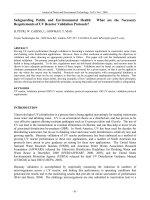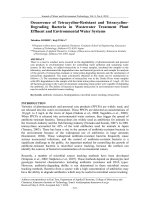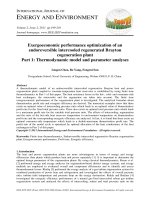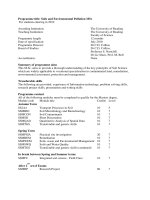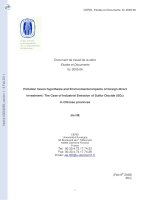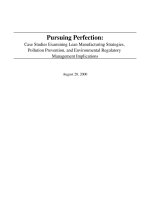- Trang chủ >>
- Khoa Học Tự Nhiên >>
- Vật lý
nanochromatography and nanocapillary electrophoresis. pharmaceutical and environmental analyses, 2009, p.282
Bạn đang xem bản rút gọn của tài liệu. Xem và tải ngay bản đầy đủ của tài liệu tại đây (8.5 MB, 282 trang )
NANOCHROMATOGRAPHY
AND NANOCAPILLARY
ELECTROPHORESIS
NANOCHROMATOGRAPHY
AND NANOCAPILLARY
ELECTROPHORESIS
Pharmaceutical and Environmental
Analyses
IMRAN ALI
HASSAN Y. ABOUL-ENEIN
VINOD K. GUPTA
Copyright # 2009 by John Wiley & Sons, Inc. All rights reserved
Published by John Wiley & Sons, Inc., Hoboken, New Jersey
Published simultaneously in Canada
No part of this publication may be reproduced, stored in a retrieval system, or transmitted in any form
or by any means, electronic, mechanical, photocopying, recording, scanning, or otherwise, except as
permitted under Section 107 or 108 of the 1976 United States Copyright Act, without eitherthe prior written
permission of the Publisher, or authorization through payment of the appropriate per-copy fee to the
Copyright Clearance Center, Inc., 222 Rosewood Drive, Danvers, MA 01923, (978) 750-8400, fax (978)
750-4470, or on the web at www.copyright.com. Requests to the Publisher for permission should be
addressed to the Permissions Department, John Wiley & Sons, Inc., 111 River Street, Hoboken, NJ
07030, (201) 748-6011, fax (201) 748-6008, or online at http:// www.wiley.com/go/permission.
Limit of Liability/Disclaimer of Warranty: While the publisher and author have used their best efforts
in preparing this book, they make no representations or warranties with respect to the accuracy or
completeness of the contents of this book and specifically disclaim any implied warranties of
merchantability or fitness for a particular purpose. No warranty may be created or extended by sales
representatives or written sales materials. The advice and strategies contained herein may not be suitable
for your situation. You should consult with a professional where appropriate. Neither the publisher nor
author shall be liable for any loss of profit or any other commercial damages, including but not limited
to special, incidental, consequential, or other damages.
For general information on our other products and services or for technical support, please contact our
Customer Care Department within the United States at (800) 762-2974, outside the United States at
(317) 572-3993 or fax (317) 572-4002.
Wiley also publishes its books in a variety of electronic formats. Some content that appears in print may not
be available in electronic formats. For more information about Wiley products, visit our web site at www.
wiley.com.
Library of Congress Cataloging-in-Publication Data:
Ali, Imran.
Nano chromatography and nano capillary electrophoresis: pharmaceutical and environmental
analyses / Imran Ali, Hassan Y. Aboul-Enein, Vinod K. Gupta.
p.; cm.
Includes bibliographical references and index.
ISBN 978-0-470-17851-5 (cloth)
1. Chromatographic analysis. 2. Capillary electrophoresis. 3. Drugs—Analysis.
4. Pollutants—Analysis. 5. Environmental pollutants—Analysis. 6. Nanoparticles—Analysis.
I. Aboul-Enein, Hassan Y. II. Gupta, Vinod Kumar, 1953– III. Title.
[DNLM: 1. Nanotechnology—methods. 2. Electrophoresis, Capillary—methods.
3. Environmental Pollutants—analysis. 4. Pharmaceutical Preparations—analysis.
QT 36.5 A398n 2009]
QP519.9.C47A45 2009
543
0
.8—dc22
2008033275
Printed in the United States of America
10987654321
To the memories of my late parents:
Basheer Ahmed and Mehmudan Begum.
I. A.
To my wife, Nagla, whose love and devotion
have been an inspiration to me.
H. Y. A E.
To the memory of my late father Sri Jeewan Lal Gupta
who has been my mentor all through.
V. K. G.
CONTENTS
PREFACE xiii
ACKNOWLEDGMENTS xv
1 Introduction 1
1.1. Nanoanalyses / 1
1.2. Definition of Nanochromatography and Nanocapillary
Electrophoresis / 2
1.3. Nanochromatography and Nanocapillary Electrophoresis / 3
1.4. Fabrication of Microdevices / 4
1.5. Developments in Nanoanalyses / 6
1.6. Data Integration / 7
1.7. Protocol of Nanoanalyses / 10
1.8. Scope of the Book / 12
1.9. Conclusion / 12
References / 12
2 Fabrication of Microchips 17
2.1. Introduction / 17
2.2. Substrates / 18
vii
2.3. Techniques of Fabrication / 20
2.3.1. Glass Chips / 22
2.3.2. Quartz Chips / 28
2.3.3. Silica Chips / 31
2.3.4. Polymer Chips / 34
2.3.5. Plastic Chips / 36
2.3.6. Chips and the Polymerase Chain Reaction / 37
2.4. Surface Modification / 39
2.4.1. Modification by Polymers / 40
2.4.2. Modification by Silica Gel / 42
2.4.3. Modification by Monolithics / 44
2.4.4. Modification by Sulfonation / 44
2.5. Designs of Chips / 45
2.6. Bindings in Chips / 49
2.7. Conclusion / 50
References / 51
3 Instrumentation of Nanochromatography and
Nanocapillary Electrophoresis 59
3.1. Introduction / 59
3.2. Nanoliquid Chromatography (NLC) / 60
3.2.1. Mobile Phase Reservoirs / 62
3.2.2. Mobile Phases and Flow Calibration / 62
3.2.3. Mobile Phase Tubings / 63
3.2.4. Solvent Delivery Pump / 64
3.2.5. Sample Injector / 66
3.2.6. Separation Chips / 68
3.2.7. Detectors / 70
3.2.8. Recorder / 71
3.2.9. Sample Preparation Units / 72
3.3. Nanocapillary Electrophoresis / 74
3.3.1. Separation Chip / 76
3.3.2. Background Electrolyte and
Its Reservoirs / 79
3.3.3. Sample Injection Port / 79
3.3.4. Detectors / 82
viii CONTENTS
3.3.5. Recorder / 83
3.3.6. Sample Preparation Units / 83
3.4. Conclusion / 85
References / 86
4 Detection in Nanochromatography and
Nanocapillary Electrophoresis 91
4.1. Introduction / 91
4.2. Mass Spectrometer Detectors / 92
4.3. Fluorescence Detectors / 97
4.4. Electrochemical Detectors / 99
4.5. Element Specific Detectors / 101
4.6. Miscellaneous Detectors / 103
4.7. Conclusion / 105
References / 105
5 Sample Preparation in Nanochromatography
and Nanocapillary Electrophoresis 109
5.1. Introduction / 109
5.2. Sample Preparation / 111
5.3. Sampling / 111
5.3.1. Biological Samples / 111
5.3.1.1. Blood / 112
5.3.1.2. Urine / 112
5.3.1.3. Tissues / 112
5.3.1.4. Plants / 113
5.3.1.5. Food Stuffs / 113
5.3.2. Environmental Samples / 113
5.3.2.1. Air / 113
5.3.2.2. Water / 114
5.3.2.3. Sediment and Soils / 115
5.4. Preservation / 115
5.5. Filtration / 116
5.6. Digestion/Homogenization / 118
5.7. Extractions / 119
5.8. Clean Up / 119
5.9. Preconcentration / 121
CONTENTS ix
5.10. Off-Line Nanosample Preparation Methods / 121
5.10.1. Nano Solid Phase Extractions / 121
5.10.2. Nano Membrane Extractions / 123
5.10.3. Nano Miscellaneous Extractions / 124
5.11. Online Nanosample Preparation Methods / 125
5.12. Conclusion / 138
References / 138
6 Nano-High Performance Liquid Chromatography 145
6.1. Introduction / 145
6.2. Nano-HPLC / 146
6.3. Applications / 146
6.3.1. Nano-HPLC of Biological Matrices / 146
6.3.1.1. Proteomics / 147
6.3.1.2. Drugs Development and Design / 151
6.3.1.3. Environmental Analysis / 155
6.4. Optimization of Separations in Nano-HPLC / 161
6.5. Troubleshooting in Nano-HPLC / 161
6.6. Conclusion / 161
References / 162
7 Nanocapillary Electrochromatography and
Nanomicellar Electrokinetic Chromatography 167
7.1. Introduction / 167
7.2. Nanocapillary Electrochromatography / 167
7.2.1. Biological Samples / 168
7.2.2. Environmental Samples / 177
7.2.3. Mechanism of Separation / 181
7.3. Nanomicellar Electrokinetic
Chromatography / 181
7.3.1. Biological Samples / 182
7.3.2. Environmental Samples / 184
7.3.3. Mechanisms of Separation / 187
7.4. Conclusion / 188
References / 188
x CONTENTS
8 Nanocapillary Electrophoresis 191
8.1. Introduction / 191
8.2. Optimization / 192
8.3. Applications / 200
8.3.1. Proteomics / 200
8.3.2. Genomics / 205
8.3.3. Amino Acids / 210
8.3.4. Drug Development and Design / 211
8.3.5. Enzymes and Hormones / 214
8.3.6. Biological Fluids / 218
8.3.7. Foods and Beverages / 221
8.3.8. Viruses and Bacteria / 224
8.3.9. Explosives / 226
8.3.10. Environmental Analyses / 228
8.3.11. Miscellaneous Applications / 232
8.4. Mechanism of Separation / 234
8.5. Conclusion / 234
References / 235
9 Chiral Separations by Nanoliquid Chromatography
and Nanocapillary Electrophoresis 245
9.1. Introduction / 245
9.2. Nanoliquid Chromatography / 246
9.3. Nanocapillary Electrophoresis / 249
9.4. Mechanisms of Chiral Separation / 260
9.5. Conclusion / 261
References / 261
10 Perspectives on Nanoanalyses 263
10.1. Introduction / 263
10.2. Future of Microfluidic Devices / 264
10.3. Future Challenges / 265
10.4. Conclusion / 266
References / 267
Subject Index 269
CONTENTS xi
PREFACE
With the advancement of science and technology, nanoanalysis is becoming
more important because scientists, academicians, and regulatory authorities
are asking for data detection at the nanogram level. This need is especially
pressing in genomics, proteomics, and drug designing and development pro-
grams. Our search of the literature and experience dictates that chip-based
analytical techniques viz. nanoliquid chromatography and nanocapillary elec-
trophoresis are the best choices for such types of applications. Therefore, the
separation and identification of many compounds in biological and environ-
mental matrices at nanolevels are gaining importance day by day. In view of
these facts, this book deals with the fabrication of microfluidic devices, instru-
mentation, detection, sample preparation, and applications of nanoliquid
chromatography and nanocapillary electrophoresis techniques for analyses at
the nanogram level. This book describes analyses at the nanogram-per-level
in detail with main emphasis on experimental methodologies. Moreover, we
explain optimization strategies, helpful to design future experiments in this
area. This book is important and unique because it is one of the first texts to
be published that addresses chip-based nanoanalyses. This is a useful reference
for scientists, researchers, academicians, and graduate students working in the
xiii
field of nanoanalyses. Uniquely, this book also fulfills the requirements of
regulatory authorities for formulating regulations and legislations to control
the dosage of drug and contaminant exposure to the environment.
I
MRAN ALI
HASSAN Y. ABOUL-ENEIN
VINOD K. GUPTA
New Delhi, India
Cairo, Egypt
Roorkee, India
January 2009
xiv PREFACE
ACKNOWLEDGMENTS
It was indeed a difficult task for me to complete this book but the extreme help
and cooperation of my wife, Seema Imran, made it reality. Thanks also to my
dear son, Al-Arsh Basheer Baichain, who has given me freshness and
fragrance continuously during the completion of this difficult job. I acknowl-
edge my other family members, relatives, and laboratory staff who have helped
me directly and indirectly during this period.
My sincere thanks to Professor Kishwar Saleem and Professor Tabrez A.
Khan, Department of Chemistry, JMI, New Delhi, who helped me to com-
plete this book. Moreover, their constant and continuous moral support was
the biggest help and a memorable event in my life. Finally, John Wiley &
Sons is also acknowledged for providing financial assistance to complete
this work. Reader comments are welcome at my email address:
I. A.
I am grateful to my wife, Nagla El-Mojadaddy, for her forbearance and support
throughout the preparation of this book and it is to her that I extend my deepest
gratitude. I acknowledge her patience and tolerance during the preparation of
this book.
Thanks are extended to the editorial staff of John Wiley & Sons for their
assistance in publishing this book.
H. Y. A E.
xv
I acknowledge the love of my mother, Smt. Kiran Devi, my wife, Prerna
Gupta, my son, Rajat Shikhar Gupta, my daughter, Vartika Gupta, and grand-
daughter, Shiriya Gupta, who have been the sources of inspiration and given
me freshness and fragrance continuously during the completion of this job.
Acknowledgments are also due to my other family members, relatives, and
laboratory staff who have helped me directly and indirectly during this period.
V. K. G.
xvi ACKNOWLEDGMENTS
CHAPTER 1
INTRODUCTION
1.1. NANOANALYSES
Separation science is the backbone of biological, biotechnological, chemical,
pharmaceutical, environmental, geochemical, and agricultural disciplines and,
hence, analysis is an integral part of these fields [1,2]. It is a well-known fact
that almost all drugs work at low concentrations in biological systems and
to carry out pharmacokinetic and pharmacodynamic studies analytical tech-
niques should be capable of detecting drugs and pharmaceuticals at nano or
lower detection limits. In spite of the curative properties of drugs, some
drugs also have side effects even at low concentrations, that is, ranging from
nanogram to femtogram levels [3,4]. Therefore, in the absence of techniques
capable of detecting at the nanolevel we assume the absence of drug residues
in the body, while these can have some bioreactions and side effects. Besides,
the concentrations of some species, such as hormones, RNA, DNA, anti-
bodies, and other proteins are very low, and require analytical techniques
with low detection limits. In addition, detection of drugs at a lower concen-
tration is required in the plasma of infants because of the availability of only
limited amounts of blood samples. In addition, for some biological fluids,
such as cerebrospinal fluids, only small volumes are available for sampling.
Besides, high throughput screening (HTS) and drug discovery (combinatorial
Nanochromatography and Nanocapillary Electrophoresis. By Ali, Aboul-Enein, and Gupta
Copyright # 2009 John Wiley & Sons, Inc.
1
chemistry) need low level analyses. Moreover, recent advancements in proteo-
mics and genomics compel scientists to develop nanoanalytical techniques.
Similarly, many xenobiotics, such as pesticides, polynuclear aromatic
hydrocarbons (PAHs), polychlorinated biphenyls (PCBs), polybrominated
diphenyl ethers (PBDEs), plasticizers, phenols, and some other drug residues,
are also toxic even at trace levels present in the earth’s ecosystem [5–7].
Without analytical techniques capable of detecting them at nanolevels, we
assume the absence of these pollutants in the environment, while these
notorious pollutants accumulate in our body tissues resulting in various
diseases and side effects such as carcinogenesis and failure of many vital
body organs including the kidney, liver, and heart [8–11]. Under such
situations, it is essential to have analytical techniques that can detect drugs,
pharmaceuticals, and xenobiotics in biological and environmental samples
at very low concentrations.
Apart from the above requirements of nanoanalyses, the need of detection at
the nanolevel is also increasing continuously in dosage formulations, food
products, and other chemical and biotechnology industries. Briefly, nowadays,
nanoanalysis is becoming more important and scientists and regulatory auth-
orities are asking for data on detection at the nanogram level. Among various
analytical techniques, chromatography and capillary electrophoresis are the
choice of scientists, academicians, and clinicians as these techniques can
analyze samples of low volume or having poor ingredient concentrations.
Some attempts have been made to develop nanochromatography and nano-
capillary electrophoresis, which some workers call the micrototal-analysis
system (m-TAS). In this book we have replaced m-TAS with the phrase
nanoanalysis as the techniques are capable of dealing with nano amounts of
samples, with detection at the nanogram level.
1.2. DEFINITION OF NANOCHROMATOGRAPHY AND
NANOCAPILLARY ELECTROPHORESIS
Karlsson and Novotny [12] introduced the concept of nanoliquid chromato-
graphy in 1988. The authors reported that the separation efficiency of slurry
packed liquid chromatography microcolumns (44 mm, id) was very high.
Since then, many advance have been reported in this modality of chromato-
graphy and it has been used as a complementary and/or competitive separation
method to conventional chromatography. Unfortunately, to date no correct and
specific definition of this technique has been proposed, probably due to the use
of varied column sizes (10 to 140 mm). Some definitions of nanoliquid chrom-
atography are found in the literature based on column diameter and mobile
2 INTRODUCTION
phase flow rates [13–15]. It has been reported that when the chromatographic
separation is carried out in capillary columns of 10 to 100 mm internal
diameter, the modality is called nanoliquid chromatography, whereas when
capillaries of 100 to 500 mm internal diameter are used the technique is
called capillary liquid chromatography [16]. On the other hand, some workers
define nanoliquid chromatography as the chromatographic modality having a
mobile flow rate of nanomilliliters per minute. However, no one has con-
sidered the detection aspect of this type of chromatography, which is very
important in analytical science.
Our intention is to achieve nanolevel detection irrespective of the exper-
imental condition as detection is the final aim in separation science.
Moreover, nanolevel detection is required for low amounts of sample or
samples having poor ingredients. Therefore, if the technique is capable of
detecting at low or nanolevels one can analyze low volume samples or samples
having poor concentrations. Therefore, detection is the most important issue in
nanochromatography. Based on these requirements and logics we have defined
nanoliquid chromatography more accurately and scientifically. Keeping all
these facts in mind, nanochromatography may be defined as “a modality of
chromatography involving samples in nanoliters, mobile phase flow in nano-
milliliters per minute, with detection at the nanogram per milliliter level.” This
definition is a complete one and all the requirements can be fulfilled on chip-
based chromatography. Therefore, a true and complete nanochromatography is
only possible on a chip, which is called lab-on-chip chromatography but we
simply named it nanochromatograpy (NC) broadly. In the case of liquid
chromatography it may be called nanoliquid chromatography and abbreviated
as NLC. The same definition is also true and complete for capillary electro-
phoresis, which is also possible on chips, and we have termed it nanocapillary
electrophoresis (NCE).
1.3. NANOCHROMATOGRAPHY AND NANOCAPILLARY
ELECTROPHORESIS
Recently, the word nano has become a trend in science and technology and
some of us think that it is the new generation but, as mentioned above, its
root is about 22 years old. NLC and NCE are gaining importance day by
day. They are very useful and effective tools for samples of low quantities
or having low concentrations of the analytes. Columns of low internal diameter
are ideal for use in NLC and NCE, especially with detectors requiring very low
flow rates, such as electrospray liquid chromatography/mass spectroscopy
(LC/MS). Besides, these columns offer high sensitivity due to their low
1.3. NANOCHROMATOGRAPHY AND NANOCAPILLARY ELECTROPHORESIS 3
dispersion characteristics. The microfluidic systems are more or less capable of
replacing conventional “macro” systems for many applications in the life
sciences. The working principle of NLC and NCE are the same as in conven-
tional LC and CE. However, miniaturization offers many advantages over the
conventional methods, including:
†
Usefulness and effectiveness for samples of low volume or having
extremely low concentrations of ingredients.
†
Significantly reducing solvent consumption and subsequent waste
production.
†
Inexpensive due to low consumption of solvent, electricity, and
operational time.
†
Good potential portability due to a system size reduction.
†
High sensitivity, speed, and reproducibilities.
†
Narrowing the peak width of chromatogram/electropherogram due to
better separation efficiency.
†
Low mobile phase pressure in NLC.
†
Simultaneous mass separation on chips.
†
Good hyphenation of detectors requiring mobile phase flow.
NCE is a relatively new development in separation science, especially in
proteomics and genomics. In the last two decades NCE has gained increasing
importance, as can be seen from a good number of publications [17–20]. In
addition to the above advantages, NCE is a suitable technique for samples that
may be difficult to separate by NLC as the principles of separation are entirely
different. Lower detection limits of NCE lead to the possibility of separating
and characterizing small quantities of materials. Moreover, the enzymatic
reactions for analytical purposes can be conducted within the capillary.
1.4. FABRICATION OF MICRODEVICES
The fabrication of microdevices in NLC and NCE is controlled by highly
developed batch-processing techniques of integrated circuits. The micro-
electronic technology can be exploited for microflow systems with functions
different from those of integrated circuits. Special processes and materials
are needed, called micromachining techniques [21]. Following developments
in miniaturization and integration of electronic devices, the potential of a simi-
lar revolution also emerged for mechanical and later on fluidic devices, which
4 INTRODUCTION
led to MEMS (microelectromechanical systems) and m-TAS (micrototal
analysis systems) [22]. m-TAS is one of the fastest growing areas covering
microfluidics, material science, analytical chemistry, and biotechnology.
Microfluidics refers to the science and technology dealing with minute
amounts of fluids (micro-, nano-, and picoliters). Lab-on-a-chip is a miniatur-
ization and integration of complete functionality of a chemistry or biology lab,
for example, preparation, reactions, separation, and detection, onto a single
chip. m-TAS is a development involving reduced size, low power, sample,
reagent and manufacture requirements and operating costs. Besides, m-TAS
can perform better services in terms of speed, throughput, mass sensitivity,
and automation.
Microfluidics is the key to NLC and NCE, the miniaturized microfluidic
system that can automatically carry out all the necessary functions to transform
chemical information into electronic information. The first m-TAS device was
developed by Terry et al. [23] for gas chromatography, which did not gain
popularity at that time, probably due to poorly developed microfluidic devices.
In 1990, Manz et al. [24] introduced the concept of m-TAS. Nowadays, m-TAS
is a popular development in various disciplines and has been reviewed by
Manz and coworkers [25–28].
The development era of microdevices was from 1970 to 1980 in the silicon
microprocessors industry. Interested readers can consult textbooks on this sub-
ject [29–31]. Kim et al. [32] presented a molding protocol for patterning net-
work channels by contacting a substrate and a patterned elastomeric master.
Later on Mrksich and Whitesides [33] used microcontact printing to pattern
structures of self-assembled monolayers (SAMs) on the submicrometer
scale. In 1996, Zhao et al. [34] used microtransfer molding for fast fabrication
of organic polymers and ceramics in three dimensions using a layer-by-layer
structuring. Park and Madou [35] designed a three-dimensional electrode
useful for a high throughput dielectrophoretic separation/concentration/
filtration system. Clicq et al. [36] used reversed phase chromatography on a
rectangular glass chip coated with C
8
silica gel. Many other attempts have
been made by various workers toward fabrication of microdevices [37–42].
The design of microdevices is a very important issue, especially in NLC and
NCE. Bousse et al. [43] reported a microfabricated electrokinetic device
having loading and separation channels. Manz and Becker [44] developed a
design in NCE useful for effective working of the system. The introduction of
stationary phases in NLC is quite difficult; however, some workers have
attempted this [45–48]. The stationary phases were introduced into a microchan-
nelbycoating of the innersurface of the capillaryorbypackingthe channelsor in
situ polymerization of continuous beds. Some microfluidic-NLC chips havebeen
commercialized by a few manufacturers.
1.4. FABRICATION OF MICRODEVICES 5
1.5. DEVELOPMENTS IN NANOANALYSES
Karlsson and Novotny [12] introduced the nanoliquid chromatography
(nano-LC) concept and since then it has been proposed as a complementary
and/or competitive separation method to conventional liquid chromatography.
Nano detection is being achieved by modified LC systems but it is still in its
development stage [49]. Generally, column internal diameters in the range
of 25 to 100 mm are considered under nanochromatographic systems. But
the miniaturization and integration of electronic devices led to the develop-
ment of microelectromechanical systems (MEMS) and micrototal analysis
systems (m-TAS), which are components of chip-based analytical machines
as MEMS devices are faster, selective, sensitive, and economic in nature.
m-TAS is a fast-growing area in separation science. Of course, lab-on-chip sys-
tems are not yet fully developed but demand for them is increasing due to their
economic, fast, and portable capabilities. A complete analysis can be carried
out in seconds by using 1 to 5 mL of solvent. Moreover, the machines are
very compact and can be carried to sites for environmental analyses.
Some important developments and advances in NLC and NCE are
described in papers by Manz and coworkers [25–28]. These authors [50] pre-
sented a miniaturized open-tubular liquid chromatograph on a silicon wafer
with a 5 Â 5 mm silicon chip containing a conductometric detector, connected
to an off-chip conventional LC pump and valves to perform high-pressure
liquid chromatography. Manz et al. [24] proposed a m-TAS concept in
which silicon chip analyzers having sample pretreatment, separation, and
detection played a fundamental role. In the early stage the intention of minia-
turization was to increase analytical performance of the device rather
than reduction in size. It was also realized that miniaturization provided the
advantages of a smaller consumption of reagent and time. Moreover, m-TAS
provided an integration of separation techniques, as it is capable of performing
sample handling, analysis, and detection on a single chip. Later, Jacobson et al.
[51] used a microchip of fused quartz to separate complexed metal ions in
polyacrylamide-modified channels. In the same year Ocvirk et al. [45] devel-
oped NLC with a split injector, a packed small-bore column, a frit, and an optical
detector cell onto a silicon chip. Moore et al. [52] reported chip-based micellar
electrokinetic capillary chromatography (MECC) of neutral dyes. Similarly,
von Heeren et al. [53] analyzed biological samples on MECC fabricated
onto a chip. Penrose et al. [54] reported a centrifugal chromatograph for
reversed-phase separations. Recently, Zeng et al. [55] reported the chiral
separation of amino acids on polydimethylsiloxane (PDMS) chips.
Chip-based technology is successful in NCE over NLC due to difficulties of
integrating on chip pumps, injectors, mechanical valves, and the lack of easy
6 INTRODUCTION
flow control [56]. Besides, it is also difficult to install a stationary phase in
NLC and sealing of the microchannels, which should be perfect for the
mobile phase to flow appropriately through the stationary phase. In 1992,
Manz et al. [57,58] introduced the first NCE integrated silicon and glass
chips. The authors described the concept of m-TAS in NCE by integrating
injection, separation, and detection on the chip. Furthermore, some advance-
ment has been reported in this direction by the same workers [59–62].
Woolley et al. [63] developed capillary array electrophoresis (CAE) for the
analysis of different DNA samples. Since then much work has been done in
this area and some quite goodpapers are available, which have been considered
for preparing this book. Other developments in NCE have been reported from
time to time and can be used for the analyses of different compounds [64–83].
Another development in NCE was the enantiomeric resolution of amines on
chip-based NCE by Cong and Hauser [84]. Reviews have been published
describing various aspects of microdevices [25–28,85–91].
1.6. DATA INTEGRATION
As mentioned above, the basic principle of NLC is the same as for conventional
techniques. The separation is identified and characterized by measuring
retention times, capacity, separation, and resolution factors. Therefore, it is
necessary to explain the chromatographic terms and symbols by which the
chromatographic speciation can be understood and explained. Some of
the important terms and equations of the chromatographic separations are dis-
cussed below. The chromatographic separations are characterized by retention
(k), separation (a), and resolution factors (Rs). The values of these parameters
can be calculated by the following standard equations [92].
k ¼ (t
r
À t
0
)=t
0
(1:1)
a ¼ k
1
=k
2
(1:2)
Rs ¼ 2 Dt
r
=(w
1
þ w
2
)(1:3)
where t
r
and t
0
are the retention time of the separated species and dead time
(solvent front) of the column in minutes/seconds, respectively. Dt, w
1
, and
w
2
are the difference in the retention times of two peaks of the separated
species, the base width of peak 1 and peak 2, respectively. If individual
values of a and Rs are 1 or greater the separation is supposed to be complete.
If the individual values of these parameters are lower than 1 the separation is
understood as partial or incomplete.
1.6. DATA INTEGRATION 7
The number of a theoretical plate (N ) characterizes the quality of a column/
chip. The larger N is, the more complicated the sample mixture that can be
separated with the column. The value of N can be calculated from the
following equations:
N ¼ 16(tr=w)
2
(1:4)
or
N ¼ 5:54[(tr)=w
1=2
]
2
(1:5)
where t
r
, w, and w
1/2
are the retention times in minutes or seconds of the peak,
peak width at the base, and at half the height of the peak, respectively. The
height equivalent to a theoretical plate [HETP (h)] is a section of a column
or chip in which the mobile and the stationary phases are in equilibrium.
Since a large number of theoretical plates are desired, h should be as small
as possible. Naturally, there are no real plates in a column or chip. The concept
of a theoretical plate is a variable and its value depends on particle size, flow
velocity, mobile phase (viscosity), and especially on the quality of the packing
h can be calculated from the following equation:
h ¼ L=N (1:6)
where L is the length of the column used.
The mechanism of separation in NCE is based on the difference in the
electrophoretic mobility of the separated species. Under NCE conditions,
the migration of the separated species is controlled by the sum of the intrinsic
electrophoretic mobility (m
ep
) and the electroosmotic mobility (m
eo
), due to the
action of electroosmotic flow (EOF). The observed mobility (m
obs
) of the
species is related to m
eo
and m
ep
by the following equation:
m
obs
¼ E(m
eo
þ m
ep
)(1:7)
where E is the applied voltage (kV).
The simplest way to characterize the separation of two components, the
resolution factor (Rs), is to divide the difference in the migration times by
the average peak width as follows:
Rs ¼ 2(t
2
À t
1
)=(w
1
þ w
2
)(1:8)
where t
1
, t
2
, w
1
, and w
2
are migration times of peak 1 and peak 2, and the
widths of peak 1 and peak 2, respectively.
8 INTRODUCTION
The value of the separation factor may be correlated with m
app
and m
ave
by
the following equation:
Rs ¼ (1=4)(Dm
app
=m
ave
)N
1=2
(1:9)
where m
app
is the apparent mobility of two separated species and m
ave
is the
average mobility of the separated moieties. Using Equation 1.9 permits
independent assessment of two factors that affect separation, selectivity and
efficiency. The selectivity is reflected in mobility of the analytes while the
efficiency of the separation process is indicated by N. Another expression
for N is derived from the following equation:
N ¼ 5:54(L=w
1=2
)
2
(1:10)
where L and w
1/2
are the capillary length and peak width at half height,
respectively. Here it is important to point out that it is misleading to discuss
theoretical plates in NCE and it is simply a carryover from chromatographic
theory. The theoretical plate in NCE is merely aconvenient concept to describe
analyte peak shape and to assess the factors that affect separation.
HETP may be considered as the function of the capillary occupied by the
analyte and more practical to measure separation efficiency in comparison
to N.
s
2
tot
is affected not only by diffusion but also by differences in the mobi-
lities, heating of the capillary in joules, and interaction of the analytes with the
capillary wall, and hence
s
2
tot
can be represented as shown in Equation 1.11.
s
2
tot
¼ s
2
diff
þ s
2
T
þ s
2
int
þ s
2
wall
þ s
2
Electos
þ s
2
Electmig
þ s
2
Sorp
þ s
2
Oth
(1:11)
where the values represent the square roots of the standard deviations of total,
diffusion, heat, injection, wall, electroosmosis, electromigration, sorption, and
other phenomena, respectively.
Practically, velocity (v) and observed mobility (m
obs
) of the analyte, electro-
phoretic mobility (m
ep
), and electroosmotic mobility (m
eo
) can be calculated by
the following equations.
v ¼ m
obs
E (1:12)
where E is the strength of the electric field in V/cm.
E is described by the following equation:
E ¼ V=Lt (1:13)
where Lt is the total length of the capillary or channel.
1.6. DATA INTEGRATION 9
By putting the value of Equation 1.13 into Equation 1.12
v ¼ (m
obs
V)=Lt
or
m
obs
¼ (vLt)=V (1:14)
We know that the velocity (v) of the analyte equals distance divided by time
and, hence, velocity in NCE may be written by the following equation:
v ¼ Ld=td (cm sec
À1
)(1:15)
where Ld and td are the distance of the capillary or channel up to the detector
point and the time of migration of the analyte up to the detector, respectively.
By putting the value of v from Equation 1.15 into Equation 1.14
m
obs
¼ (Ld=td) Â(Lt=V)(1:16)
or
m
ep
þ m
eo
¼ (Ld=td) Â(Lt=V)(1:17)
For benzene the value of m
ep
is zero and hence:
m
eo
¼ Ld=td  Lt=V (cm
2
V
À1
sec
À1
)(1:18)
Equation 1.17 may be written in the following form:
m
ep
¼ Ld=td  Lt=V Àm
eo
(cm
2
V
À1
sec
À1
)(1:19)
By using all these equations, we can calculate all parameters of NCE required
in any analysis.
1.7. PROTOCOL OF NANOANALYSES
Of course, conventional chromatographic and capillary electrophoretic methods
are popular for the analyses of drugs, pharmaceuticals, and pollutants in biologi-
cal and environmental matrices. In the last few decades, new developments in
nanoanalyses have emerged in the literature due to their high separation efficacy,
speed, inexpensive running cost, and small volume requirement, which are major
10 INTRODUCTION
trends in analytical science. The number of publications in separation science
using this development have increased. Use of these techniques is difficult
because it involves micro or nano amounts of samples. A well-trained operator
is required for handling NLC and NCE. A good protocol is always useful to
workwith these modalities of chromatography and electrophoresis. Theworking
protocol for NCL andNCEisshown in Fig.1.1andacareful perusal of thisfigure
indicates that sample preparation is a very important issue in these modalities,
especially in unknown matrices. Our experience dictates that online sample
preparation devices are required to avoid any error of methods due to small
sample quantities. Optimization and other issues related to nanoanalyses are
discussed in later chapters of the book.
Figure 1.1 Protocol for analyses at nanolevels.
1.7. PROTOCOL OF NANOANALYSES 11

